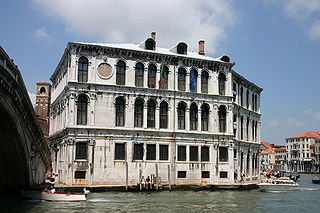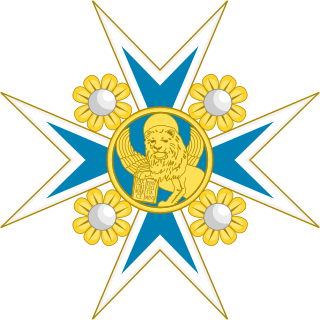Related Research Articles

The Dogado or Duchy of Venice was the homeland of the Republic of Venice, headed by the Doge. It comprised the city of Venice and the narrow coastal strip from Loreo to Grado, though these borders later extended from Goro to the south, Polesine and Padovano to the west, Trevisano and Friuli to the north and the mouth of the Isonzo to the east.

The office of Procurator of Saint Mark was one of the few lifetime appointments in the government of the Venetian Republic and was considered second only to that of the doge in prestige. It was routinely occupied by nobles belonging to the most influential families and typically represented the climax of a distinguished political career, although it was often an intermediate position prior to election as doge.

The Senate, formally the Consiglio dei Pregadi or Rogati, was the main deliberative and legislative body of the Republic of Venice.

The Great Council or Major Council was a political organ of the Republic of Venice between 1172 and 1797. It was the chief political assembly, responsible for electing many of the other political offices and the senior councils that ran the Republic, passing laws, and exercising judicial oversight. Following the lockout of 1297, its membership was established on hereditary right, exclusive to the patrician families enrolled in the Golden Book of the Venetian nobility.
The Council of Forty, also known as the Quarantia, was one of the highest constitutional bodies of the Republic of Venice, with both legal and political functions as the supreme court.
The Avogadori de Comùn, literally "public prosecutors", were an institution of the Republic of Venice. The Avogadori were responsible for taking care of and defend the interests of the Commune Veneciarum, meaning the union of noble families in the Government of Venice, in a manner similar to that of a modern State Attorney.

Palazzo dei Camerlenghi is a Renaissance palazzo in Venice, northern Italy, located in the sestiere (quarter) of San Polo. It faces the Canal Grande, adjacent to the Rialto Bridge.

The Minor Council or Ducal Council was one of the main constitutional bodies of the Republic of Venice, and served both as advisors and partners to the Doge of Venice, sharing and limiting his authority.

The Order of Saint Mark was the sole order of chivalry of the Republic of Venice. It was named in honour of Venice's patron saint, Mark the Evangelist.
The Savii or Savi del Consiglio dei Pregadi, also known as the Savi[i] Grandi, were senior magistrates of the Republic of Venice.
The Savii or Savi di Terraferma was a board of five senior magistrates of the Republic of Venice, initially charged with the defence of the Republic's possessions in the Italian mainland. Gradually they assumed specific roles pertaining to the supervision of public finances, the military administration, state ceremonies, and urgent ad hoc matters.
The Captain of the Gulf was a senior naval command of the Republic of Venice.

The Full College was the main executive body of the Republic of Venice, overseeing day-to-day governance and preparing the agenda for the Venetian Senate.

The Provveditore Generale da Mar was a senior office in the Venetian navy and in the Venetian overseas empire.

The Magistrato alla Sanità was the office of the Republic of Venice definitively instituted in 1490 to manage public health in the city of Venice and its territories, with specific attention on preventing the spread of epidemics within the maritime republic. The magistracy was among the first health authorities in Europe to institute public inoculation projects to prevent the spread of infectious diseases.
The Savi[i] agli Ordini or Savi ai Ordini were senior magistrates of the Republic of Venice, charged with supervision of maritime matters, including commerce, the Venetian navy and the Republic's oversees colonies.

The Riformatori dello studio di Padova, also Riformatori allo studio di Padova, were the three officials of the Venetian Republic responsible for overseeing education and culture. Created in 1517, initially to reopen the University of Padua after the War of the League of Cambrai, they became responsible over time for public and private schooling at all levels, public libraries in Venice and Padua, intellectual academies, and professional schools. They also reviewed and authorized for publication all books within the mainland territory of Venice.
This is an alphabetical index of people, places, things, and concepts related to or originating from the Republic of Venice. Feel free to add more, and create missing pages.
The Magistrato alle Pompe was a government department of the Republic of Venice responsible for upholding the Republic's sumptuary laws.
The Provveditori all'Armar were officials of the Republic of Venice responsible for the provisioning and equipment of the ships and crews of the Venetian navy.
